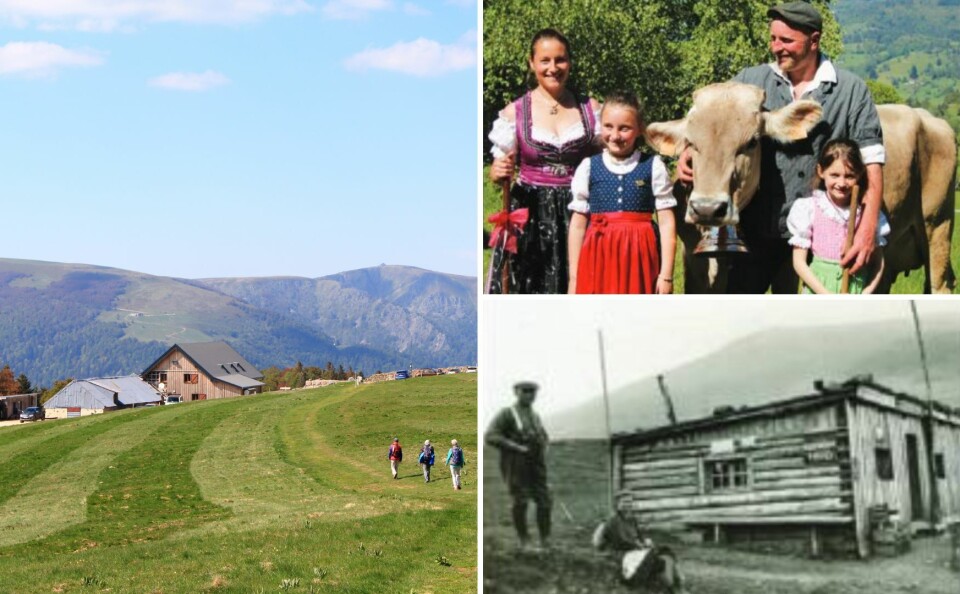-
Is now a good time to get a bargain ski holiday in France?
Offers abound for cut-price accommodation, passes, and hire as season prepares to end
-
Big limitations on number of new second homes in Chamonix
Some 70% of the housing stock in the popular mountain resort town are currently second homes
-
Man injured after skier throws large snowball from ski lift onto restaurant terrace in French Alps
The culprit was identified after he posted a video of the incident on social media
French mountain farmers keep herding and hospitality traditions alive
Culture of transhumance, good food and accommodation is passed down the generations of farmers, known as marcaires

The wide-open spaces and lush green mountains of the Massif des Vosges in eastern France have shaped the way of life for many farmers, both past and present.
In Haut-Rhin, they still practise transhumance – moving livestock from one grazing ground to another – continue traditional dairy and cheese-making methods, and welcome visitors to their fermes-auberges.
These farmers are known as marcaires – a term that dates back to the 9th century when the Hautes-Vosges was inhabited by Alsatian marcaires who introduced their language, traditions and knowledge.
Local farmers and peasants kept the name and carried out the annual custom of transhumance, a method that three-quarters of farms in the area continue to this day.
Vosgienne cattle are adapted to mountain life
Serge Sifferlen, president of the Association des fermes-auberges du Haut-Rhin, says: “In spring, the herd goes up to the summer pastures on the high stubble fields, and in the autumn it comes down to the farm in the valley.
“Most transhumance is still done on foot with the herd following long-established paths.”
Each farm chooses the breed of cattle to raise, but many opt for the traditional Vosgienne.
Distinct due to their black-speckled appearance with a long white line running down their backs, they are well adapted to mountain life.
The word marcaire is taken from the Alsatian term malker, which means ‘milker’.
These were people who were passionate about their produce and would serve a glass of milk and a piece of cheese to passers-by.
A place for pioneer hikers to eat and sleep
The creation of the Club Vosgien rambling organisation in 1872, and the opening of a walking route in 1907 between Munster and the Col de la Schlucht, increased footfall throughout the valley.
Nestled in the mountains, the marcaires’ farms were difficult to reach and accessible only via narrow paths.
For the hikers who used these paths, coming across a place that provided fresh homemade food and accommodation was a boon.
Mainly open during the summer months due to the seasonality of the pastures, the popularity of fermes-auberges quickly grew.
“In fermes-auberges there is a strong family tradition, since they are generally handed down from generation to generation.
“This also allows for the transmission of savoir-faire and family recipes,” says Mr Sifferlen.
Menus expanded and included traditional culinary specialities such as Roïgebrageldi, or pommes de terre marcaires, a dish incorporating potatoes, bacon and stewed onions.
Read more: What has been voted France’s favourite regional dish?
Ferme-auberge concept helped farms diversify
Industrialisation and war saw a gradual decline in the number of marcaires in the area.
However, fermes-auberges began to flourish once more after the end of World War Two and with the rise of cars, which made travel easier.
In 1971, the Association des fermes-auberges du Haut-Rhin was created to champion this blend of tourism and mountain farming.
It was the first of its kind in France and gave its 43 members a cohesive voice to talk about their way of life.
Three years later, the concept of the ferme-auberge was adopted nationally as a means of diversifying farms, with nearly 900 created.
Now, across France, nearly 8,000 farmers are members of Bienvenue à la ferme.
Created in 1988, this is the leading national network for direct sales and farm reception, coordinated by the Chambres d’agriculture to support farmers who offer quality products and activities.
Charter protects marcaire way of life
Meanwhile, the Association des fermes-auberges du Haut-Rhin has drawn up its own charter to protect a legacy that is specifically linked to transhumance and to maintain the authentic marcaire tradition.
To become a member, a ferme-auberge must meet four criteria: the welcome, the products, the menu and the setting.
“The association aims to promote the fermes-auberges in its network. In addition, it represents fermiers-aubergistes to the authorities, elected representatives and various partners.
“In this way, it participates in mountain development policies by defending the way fermes-auberges bring life to these regions,” says Mr Sifferlen.
Transhumance helps maintain the land
In moving the herds, fermiers-aubergistes help to maintain the land and ensure a human presence in the mountains, with attached economic and tourism benefits, he adds.
Indeed, so important is this tradition that the Organisme de Sélection de la race bovine Vosgienne is currently working towards having transhumance inscribed on the Unesco list of intangible cultural heritage.
Read more: Calls for French transhumance to be recognised as Unesco Heritage
‘Above all, you must not be afraid to work’
Michel and Julie Deybach purchased the ferme-auberge Uff Rain in Metzeral, Alsace, in 2011.
“In the summer months from May to October, we have two jobs – that of an agriculteur and that of a fermier-aubergiste. Our primary role is as a paysan (farmer). This is where the marcaire was born,” says Mr Deybach.
“During this period the cows are in pasture. We practise transhumance in mid-May, moving 25km on foot over two days. The hostel is located at an altitude of 1,180m.”
A typical day
Mr Deybach’s typical day can include milking cows, feeding calves, enlarging fences so the herd always has fresh grass, and making cheeses (Munster, Barikass, Tomme/Raclette, fromage blanc) to be served to customers.
His wife, Julie, is a crucial part of the whole operation. Alongside cheese and bacon boards, they offer meat pie, traditional Roïgebrageldi, smoked pork, calf’s head, cheese gratins, pies and other cold cuts.
“I really enjoy sharing and discussing our way of life with customers,” he says.
In the evening, Michel will collect the cows for milking and, depending on the season, he will manage other agricultural tasks, such as chopping wood, haymaking, fencing and clearing brushwood.
“When autumn arrives, the farmhouse stays open until November 1, but the cows will come down in mid-October to our winter farm at a 450m altitude.”
‘It’s not a job, it’s passion’
Winter closing offers some calm, although Mr Deybach’s daily routine does not change much. He is still up with the animals, milking, cheese-making, mulching, feeding and more.
However, this time of year does allow for meeting with family and friends.
“I was born into a family of marcaires and I cannot imagine doing anything else.
“We are very proud of our career path. Being a fermier-aubergiste is not really a job, it’s a passion. You have to love nature, animals, cooking and contact with customers.
“Above all, you must not be afraid to work,” says Mr Deybach.
“What I like most of all is to be in contact with my animals, to succeed in making quality products, and to have the recognition of the customers. It’s very rewarding for us.”
Related articles
New 3,000km hiking trail takes trekkers across ‘hidden’ France
New hiking trail follows historic transhumance routes of Provence
Which French departments have more cows, pigs and sheep than people?
























